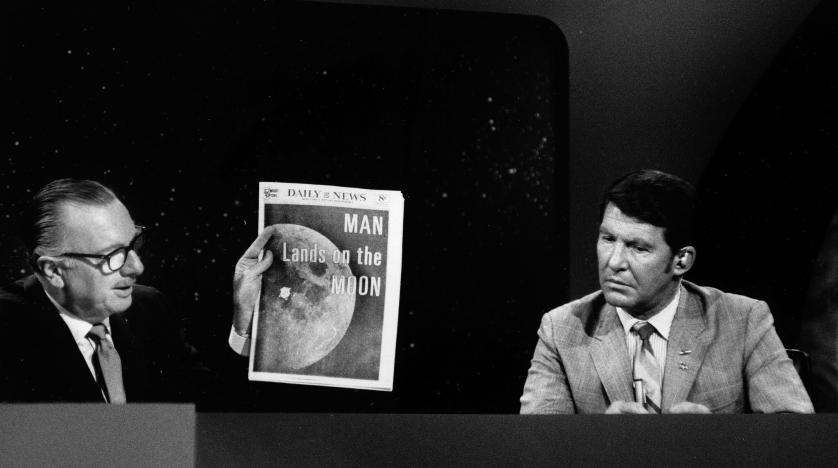The Apollo 11 Mission Was Also a Global Media Sensation

AFP
The satellites were finally ready to beam images back to Earth in 1969. And some 600 million people watched the event live.
The television news director Joel Banow absorbed endless hours of “terrible old B movies” filled with extraterrestrials and rocket ships long before he oversaw the production of an authentic space opera.
While the astronauts Neil Armstrong, Buzz Aldrin and Michael Collins were making history above, Mr. Banow played his part on the ground, helming the coverage of the Apollo 11 mission for CBS News while standing on his feet like an orchestra conductor.
Mr. Banow treated the 32 hours of programming on July 20 and July 21, 1969, like “a big blockbuster kind of motion picture,” he said in an interview, which meant days of rehearsal, custom animation and a cast of correspondents and producers so large that the end credits lasted seven minutes.
It was one of the first global news media spectaculars. The director said he had prepared for the job by having helped with the coverage of the previous Apollo missions and several Gemini and Mercury launches.
As the Eagle module touched down on the moon, applause flared up behind Mr. Banow in the CBS News studio on West 57th Street in Manhattan. He cut to Wally Schirra, a Project Mercury astronaut working as a CBS News consultant, catching the retired spaceman in the act of wiping away a tear. Mr. Banow followed that shot with a glimpse of the network’s star anchor, the usually composed Walter Cronkite, who grabbed his nose and shook his head, momentarily at a loss for words.
Hours later, at 10:56 p.m., a hazy black-and-white image flashed on the screen of Armstrong advancing gingerly down a ladder. When he stepped onto the lunar surface, Mr. Banow finally took a seat.
“I felt pride that I was a part of this, and also wonder that NASA managed to do it without a glitch,” Mr. Banow, now 84, said. “They did it. We did it. It was really kind of a relief.”
The coverage of the event had come about thanks to recent advances in media technology. In 1962, the first live trans-Atlantic broadcast — showing images of the Statue of Liberty, President Kennedy and a baseball game — was transmitted via satellite. A more ambitious live satellite broadcast, in 1967, showed the Beatles performing “All You Need Is Love” at Abbey Road Studios in London. More than 350 million people around the world were watching.
Roughly 600 million people, a fifth of the world’s population, saw Armstrong set foot on the moon, a viewership record that held until Lady Diana Spencer married Prince Charles in 1981.
All three major American broadcast networks — CBS, NBC and ABC — covered the Apollo 11 mission, with CBS dominating the ratings. In the United States, 94 percent of people watching television were tuned into the event.
People who did not own TV sets or found themselves away from home kept up with the coverage from bars, town squares and department stores, said David Meerman Scott, the co-author of the 2014 book “Marketing the Moon.”
Many astronauts and engineers resisted the live-broadcast plan, expressing concerns about the extra weight of the filming equipment. But at NASA’s insistence, Armstrong’s moonwalk was captured by a Westinghouse camera covered in a protective thermal blanket and tucked into the lunar module. The signal bounced from the module’s antenna through microwave links, satellites and landlines around the world. The picture was degraded before it reached viewers.
The BBC covered the event with less reverence than its American counterparts, dubbing David Bowie’s just-released single, “Space Oddity,” onto the footage beamed back from the moon. During a break in the action, the BBC gave viewers about five minutes of Pink Floyd jamming live from the network’s studio on a bluesy song called “Moonhead,” as well as dramatic readings with a lunar theme from Ian McKellen and Judi Dench.
Networks in the United States rounded out their coverage with hours of analysis and moon-related entertainment. On ABC, the science-fiction writer Isaac Asimov chatted with Rod Serling, the creator of “The Twilight Zone” television series. The network had also commissioned Duke Ellington to create something new for the occasion. He made his television debut as a vocalist, performing the song he had composed, “Moon Maiden,” live on the air.
Headline writers conveyed the news with attempts at deadline poetry. The Kokomo Tribune, in Indiana, went with “Astronauts Etch Names Beside History’s Great Explorers.” The Oil City Derrick, in Pennsylvania, was more succinct: “Yanks Land on Moon.” The New York Times’s banner headline — the straightforward “Men Walk on Moon” — was set in some of the largest type ever used in the paper.
The coverage of Apollo 11 was subdued in Moscow. “It was not secret, but it was not shown to the public,” Sergei Khrushchev, the son of the former Soviet leader Nikita Khrushchev, told Scientific American in 2009.
In the United States, NASA had spent years molding its astronauts into mythic figures, giving Life magazine exclusive access as part of its attempt to shape public opinion. Americans became emotionally invested in the crew members thanks to cover stories documenting the “making of a brave man” and the “inner thoughts and worries” of the spacemen’s wives.
“That had a large effect in showing how big a deal it is to go to space, and it helped to make the astronaut-as-celebrity culture come alive,” Mr. Scott, the author, said. “You’d flip through magazine pages and see Joe DiMaggio, a hero of baseball, and then a few pages later, an astronaut. That’s mythmaking.”
Latest News
 King from Mafraq: Jordan’s security, sovereignty above all considerations
King from Mafraq: Jordan’s security, sovereignty above all considerations Sunak tells Netanyahu to “allow calm heads to prevail”
Sunak tells Netanyahu to “allow calm heads to prevail” Safadi, Germany’s Baerbock discuss war on Gaza, regional escalation
Safadi, Germany’s Baerbock discuss war on Gaza, regional escalation FM, EU commissioner discuss development cooperation, regional de-escalation
FM, EU commissioner discuss development cooperation, regional de-escalation Jon Stewart unpacks Iran launching missiles at Israel
Jon Stewart unpacks Iran launching missiles at Israel
Most Read Articles
- Senate president, Iraqi president discuss bilateral ties, regional issues
- King from Mafraq: Jordan’s security, sovereignty above all considerations
- Sunak tells Netanyahu to “allow calm heads to prevail”
- JHCO dispatches 75-truck convoy of food aid to Gaza
- UN agency finds unexploded 1,000-pound bombs in Gaza schools
- Sudanese rue shattered dreams as war enters second year
- Jordan monitors citizens in UAE amid weather concerns
- Egyptian Foreign Minister condemns potential Palestinian displacement as 'war crime'
- Massive fire engulfs Copenhagen’s historic stock exchange
- IMF ups global growth forecast but signals medium-term pessimism